

 |
 |
During the course of any given year I will have done many night sky and daytime photo shoots and for some reason or other I never uploaded the images. I may have posted some on my social media pages of course however I never got around to posting on my website. This site is the heart and soul of my work and the prime place I post the best of my work, so with this in mind I thought I would update a selection of images on here captured during various times of the year as they deserve a mention and document the great memories and adventures during these times. The images are not in any particular order and I won't include specific dates.
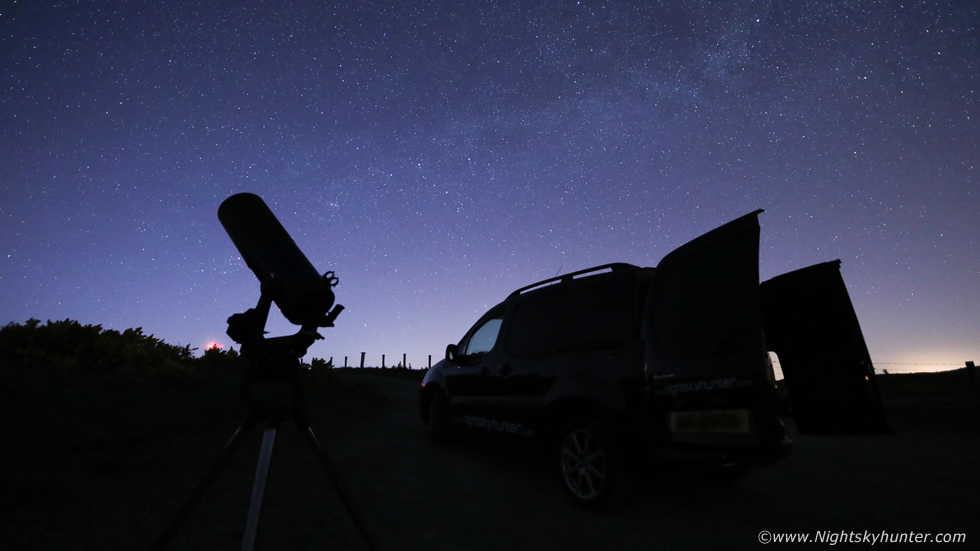 |
This brings back good memories from Spring just after we were released from full lock down. During the entire lock down period we were blessed with perfect weather and an abundance of clear nights so I used the time to get back into my visual astronomy in a serious way. I spent every clear night observing deep sky objects and comets to the point were using a telescope became like second nature and a natural thing to do. Once I was free to get back on the road again I felt over joyed to escape the trappings of the back garden and get out into a darker site and new surroundings to observe the stars, I was never taking anything for granted again. I found a new secret location on the hills in Co. Tyrone outside Cookstown, OK it's not really secret however I'm just not saying where it is because when I'm observing comets I like peace and no distractions.
So here I was with the 8" Meade LX10 S. Cass observing comets under a wonderful crystal clear sky, I have to admit it felt like a proper adventure taking my old faithful work horse scope out to a mountain location in the middle of nowhere, this scope has been by my side for 20 years or more and it was still by my side this night collecting star light and I could sense it was very happy. By the way the code name I have for this telescope is 'Discovery II' or 'DII' for short. I have a long flexi tube dew shield and an F/6.3 focal reducer to generate a wide field for comet hunting. If you look carefully you can see that I have no finderscope at all, this was lost years ago so the only way I can guide my scope manually to targets in the sky is by just sighting along the tube and hoping for the best, I've become accustomed to this and now have a good success rate with my pointing. I had just finished observing a faint comet then to document the memory I took a few images with my new full frame Canon 5D Mark IV with Irix 15mm F/2.4 Blackstone lens and experimented with the high ISO capability. This was facing N to NW along the Summer sky from Auriga, Perseus, Cassiopeia into the rising Milky Way in Cepheus and Cygnus.
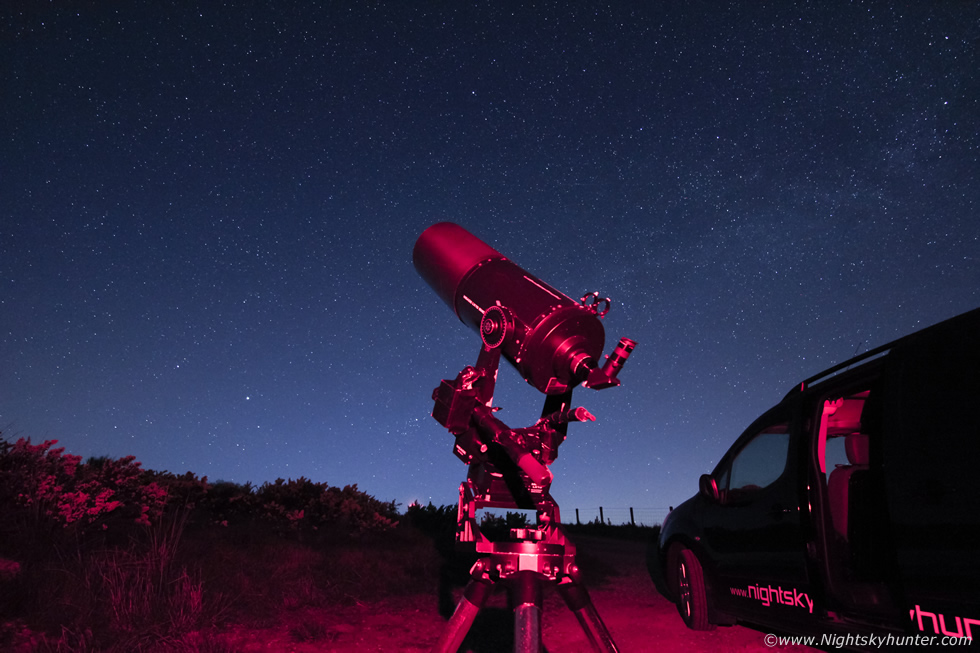 |
Using my head torch to light up the foreground. White light destroys your dark adaption, this is fine if you are just taking images but if you are into serious observing you need to protect your dark adapted eyes so red light is the best choice, I covered the lens with red insulating tape and that done the trick. You might notice I have some contraptions on the fork arms of the mount, these were modified home made adjustments to aid with comet hunting. On the right arm is the metal shaft and handle from a badminton racket and on the left a door fitting for doing sit-ups, I attached both and covered any exposed elements with black tape, it looks crude however this system has worked perfectly and has stood the test of time, I have been using the handles for 20 years and they still work, I can now sweep the telescope in azimuth with greater control and comfort. As for the rest of the scope, the clock drives doesn't work, the declination motor doesn't work either, the declination lock and slow motion controls have stopped working too and my 1.25" eyepieces have seen better days and are fairly tarnished. That being said the telescope's optics are still good and the scope moves in RA and DEC just fine so my old friend still serves me well. For those interested, it was with this telescope that I came close to discovering 153P/ Ikeya-Zhang back on the evening of February 6th 2002 when I missed the new comet by just a few degrees in the low southern sky due to smoke and murk over the town of Maghera on that still high pressure Winter evening.
 |
DII and I doing our thing. I had just finished observing two comets, both of which looked like faint fuzz balls against the background sky, one had a faint tail and both to me were cool at the time. Little did I know back then that just one month from now I would be witnessing a stunning naked eye comet rising in Auriga below the star Capella in this image in what would turn out to be the best comet in 23 years, this is why I love comets. Incidentally as I write this now during late November 2020 I'm pondering getting a new telescope, specifically for comets and deep sky only this time portability would be a factor as I would need an instrument light enough to load into the van and which can be set-up and packed away fairly easily. There's no question in my mind that the best telescope would be a Dobsonian reflector in the 8" to 10" range, however it would need to have a 2" focuser, I have been doing a little research today and not only do I like the classic Dobsonian design however I also saw a truss tube version which would be more portable, however the latter design really increases the price quite a bit, I'm just at the thinking stage at the moment and it will come down to what is actually in stock. Many people have took up Astronomy since lock down so telescopes are now on high demand and many are now out of stock, amazing times indeed.
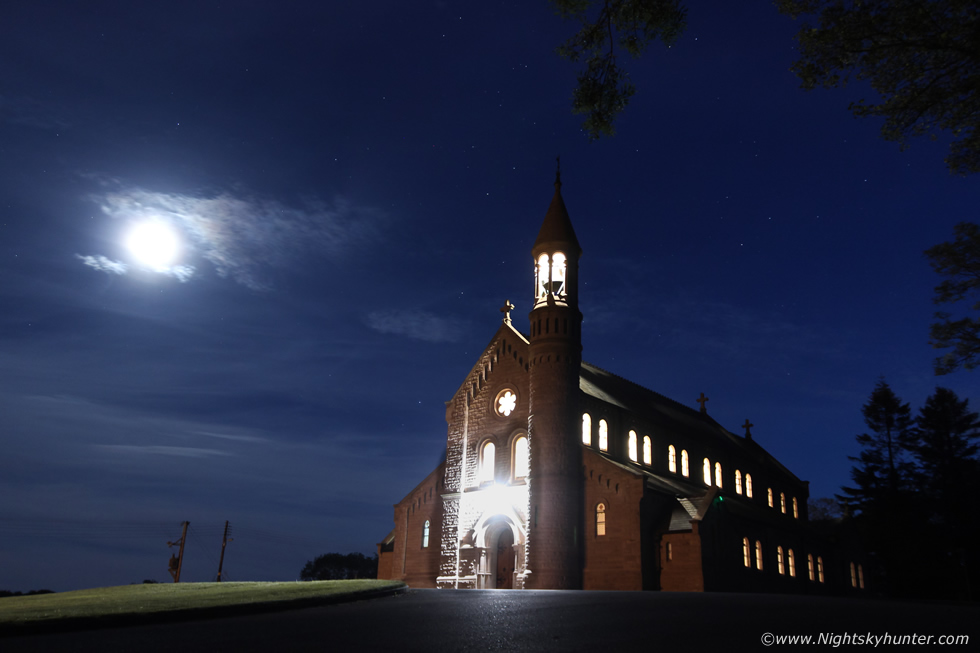 |
I can fondly recall this as a time of happiness and great freedom when full lock down ended and we began our first photo shoots together with friends. This was early June when John Fagan and I teamed up for a local shoot at a church we had never shot before. This St. Michael's church in Churchtown outside Lissan on the outskirts of Cookstown. I remember this being a balmy mild Spring night with a waxing first quarter moon in the sky. John and I shot a time lapse using two cameras showing the moon and stars setting over this wonderful church, nobody was inside at this time, however there were faint internal lights which made the windows glow orange against the twilight sky, but naturally these were burnt out in the long exposure.
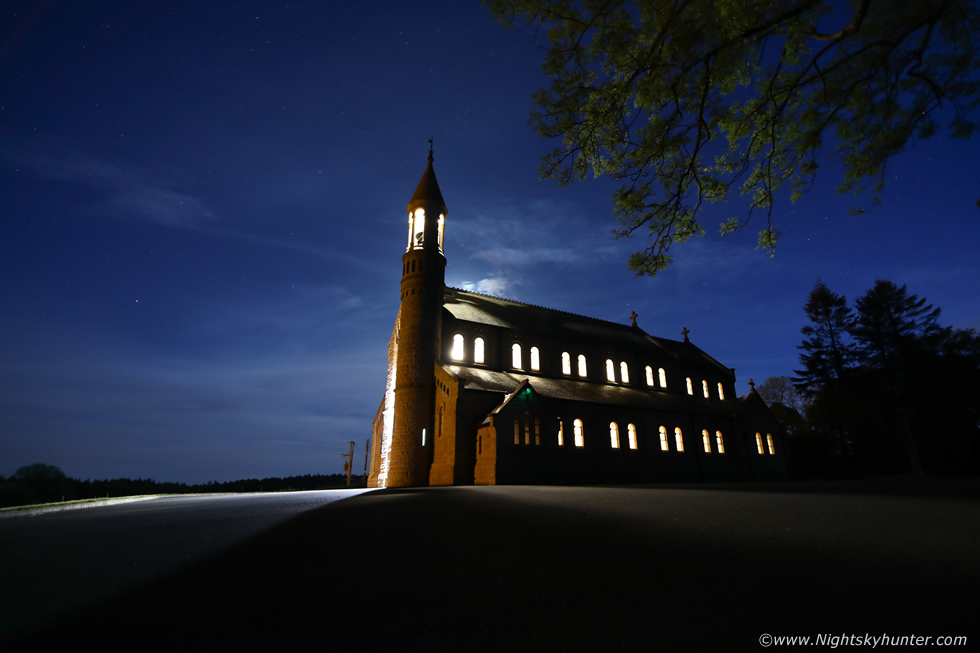 |
A very photogenic church and one which we will return too, if they could turn off the main lights above the entrance then this could have great potential at night, perhaps even with moonlit snow. We where also entering the early stages of the NLC season, John and I laughed about the thought of Thomas Romney Robinson (google him) sitting in the bell tower shouting at us to get NLCs and not being allowed to sleep for the next two months in case we missed a display. Funnily enough two hours later at this location we observed our first NLCs of the season between the trees so we changed location near Lough Fea and shot a time lapse of the display until 03.15 in the morning.
 |
Speaking of NLCs this was the first major display I observed during June. The clouds had cleared to reveal a vivid show so I hit the road outside Cookstown and began driving aimlessly around the back roads looking for a good viewpoint, I just wanted foreground, I drove for what seemed like forever wasting valuable photography time and yet I found absolutely nothing, it seemed every field had wires and poles or hills or a private farm house nearby so I just kept driving and by some random chance I ended up on the back road which took me to the top of Slieve Gallion. Those who have followed me for a long time will know that Slieve Gallion is where Conor McDonald and I did our very first storm chase in a car and what a success it was, this was one of those events which got me hooked on storms for life so it seemed the Universe had conspired to take me back here to see my first NLCs from this high vantage point.
I remember how the transition from ground level to the summit had greatly affected the weather. Lower down it was calm and warm, you could almost get away with a t-shirt for a while, but on top there was a sustained 20mph wind which was cold and nasty, it was a different world here. However the NLC display was absolutely gorgeous, I was struck by its brilliance, I suspect the higher altitude and cleaner air had made the NLCs looks more intense and in my face, I really was gob smacked by their remarkable presence, you really needed to have been here to feel that experience. This was type 5 and dominated by silver and blue waves, bands and veil forms. There was no foreground here to show the scale, all I could see were the illuminous clouds glowing in a line of puddles along a rocky trail. It seemed pure black up here which made the clouds possess an even greater presence.
I began shooting a time lapse, the tripod was getting buffeted in the wind and I wondered would it even hold. Then suddenly car lights approached me from behind, they slowed down as they crept towards me then stopped. Great, I thought this was a nutter, I felt slightly threatened because I was cornered with no escape past their car. The occupants came out and approached, I had a large maglite torch in the door which was there on purpose as a make shift weapon and I was about to grab it when the occupants spoke. It was the PSNI, I let out a sigh of relief, I was delighted to see them. Turns out they had seen the NLCs too and were mesmerized by them, they saw the writing on my van then came over for a chat. So we all observed the display for 15-20 minutes and I got a chance to explain all about NLCs and we had a thoroughly good time. It still amazes me that these vast complex night shining clouds are composed from tiny particles from ancient comets and asteroids, perhaps as old as the solar system itself, so in effect when you observe NLCs you are looking at material that's 4.5 billion years old which vastly predates Homo Sapiens and much of life on Earth.
 |
Early Summer memories of warm humid days and the only thundery outbreak we had of the entire Summer. Our chase to Mullaghmore was perhaps the finest chase experience of the year and was soon followed by more the following week when hugh storms developed over Co. Tyrone in response to very high CAPE values and sufficient moisture for deep convection, the presence of moderate to strong shear raised the ante when updraughts began to lean over venting their intense precip cores away from the updraught base which aided with cell severity and longevity. On this particular day I was all over the country catching numerous storms, however by 17.00 I got a call from Paul Martin, he had spotted, in his words, ''mental updraughts outside Omagh'', he was on the mountain with his partner Tracy watching the show. I raced up as fast as I could.
The powerful leaning white updraught which exploded above us on this humid Summer afternoon was a sight to behold, without question the largest and strongest updraught we had ever seen. The cell was flooding the mountains and local villages with torrents of rain and hail. For us on dry ground on top of the mountain it was a spectacular experience, the storm itself was gigantic with black clouds with an intense core which had subtle green colour, to the right of this was a massive solid updraught base which soon developed an RFD type slot in the base just as the core formed a rain foot, we where hearing constant thunder the entire time, why we didn't get a funnel or tornado from this powerful cell is beyond me. You can read more about this chase on the report.
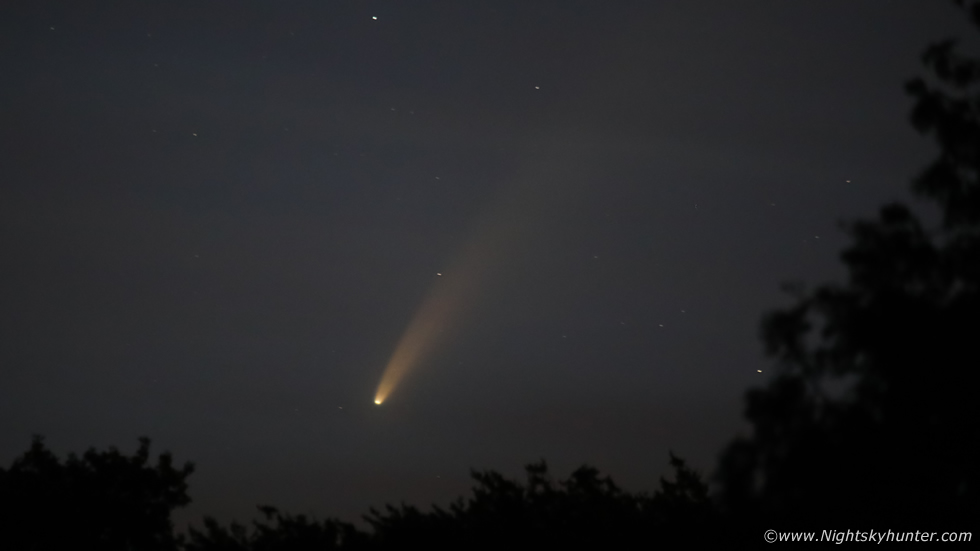 |
It would be a shame not to take a trip back to my finest personal experience of 2020, and perhaps one of the best experiences of many years. This was naked eye comet C/2020 F3 NEOWISE, I have already detailed my full adventures with this remarkable comet on a two page report however I wanted to re-visit this period and add a few more images from the files which have have not been posted in public before. I included this image because it only slightly comes close to detailing the naked eye view. This comet wasn't just remarkable for being bright, it wasn't just remarkable for its long gas and dust tails, it was remarkable for its vivid golden colour which was striking without optical aid but jaw dropping through the 8" scope.
This image was taken from a grave yard outside Omagh near mid July. I was crouching among head stones in a silent plot with Paul and Tracy, the comet was rising and was perhaps five degrees above the horizon. This combination of rich dust particles reflecting sunshine and the comet lurking through horizon haze causing extinction gave the comet its fiery look. This was a hazy warm Summer's night, my favorite time of year, and to have a naked eye comet visible at the same time was nothing short of my perfect night.
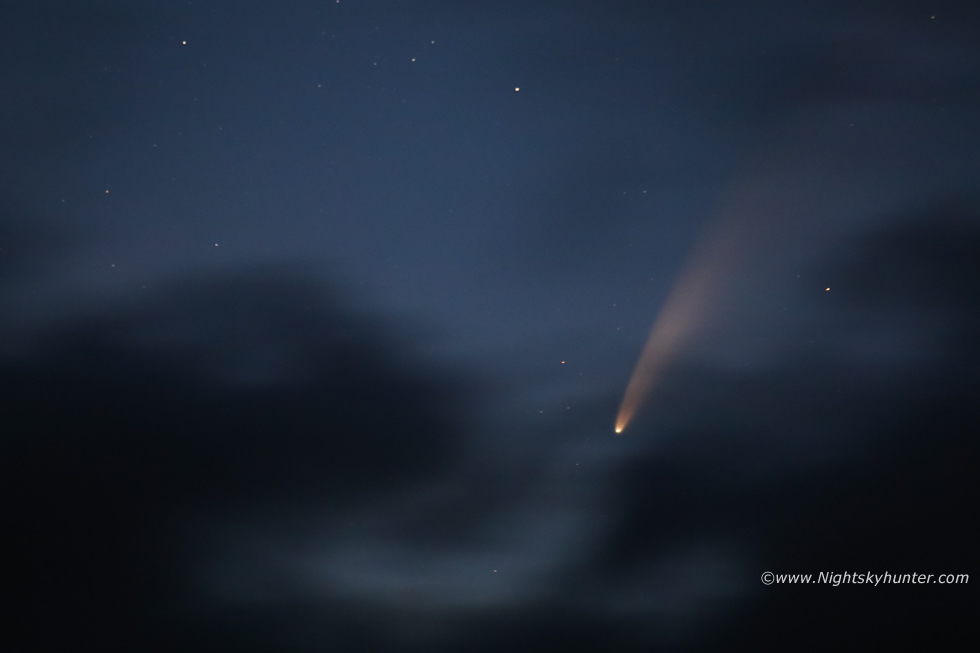 |
Another night, this time from Beaghmore Stone Circles in Co. Tyrone, NEOWISE playing peekabo with John Fagan and I as the comet briefly appeared in the gaps between cloud, to the naked eye it looked like a golden quill pen among the stars against a dark twilight sky. Not only was the comet memorable but so was this session as John and I had a great chat in the car park all about the comet and how much it impressed us, it's safe to say that NEOWISE left a lasting impression on us - as all good comets should - this comet encounter will be a night we shall never forget, the view in DII was gorgeous, we also met astrophotographer Adam Jeffers who was also imaging the comet, great to meet good people during a wonderful comet apparition.
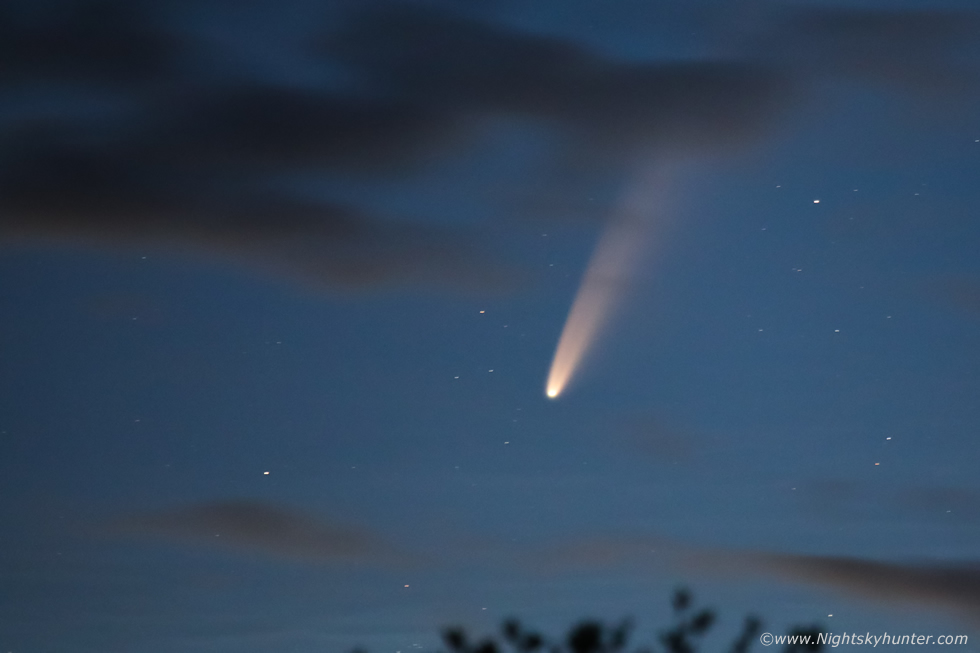 |
Beaghmore just before dawn against a rapidly brightening sky, you can see a faint display of NLCs in the form of soft edged bands below the comet. This two week comet chase was one of the highlights of my life, even though it didn't come close to the magnitude and size of Hale-Bopp I would still rank NEOWISE as one of the most beautiful sights I have ever seen in nature, especially when it rose with a tail of gold embedded within electric blue NLCs. As far as I know there haven't even been bright comet apparitions within NLCs before (I could be wrong) so this makes NEOWISE perhaps a once in a life time event. This comet satisfied my long hunger for a 'proper comet' and I felt truly satisfied and moved by what I saw, however the taste was all too brief and just as I was glowing in my element at the peak of my best ever Summer experience when the comet dived south and rapidly faded. I still miss this comet even now as I type these words however I remain optimistic of once again witnessing a truly great comet in my life time.
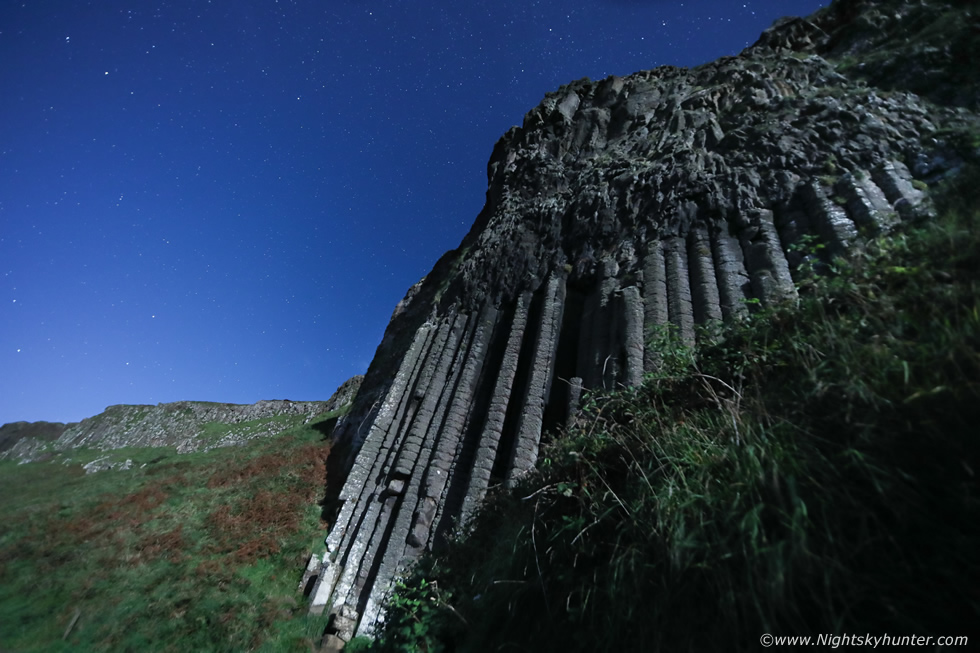 |
We transport forward in time to Autumn when I hooked up with Nigel McFarland for a night shoot on the north coast. It was one of those bright moonlit nights which we love to shoot in. We decided on the Giant's Causeway and as it happened so did other photographers so the place was a little busy and getting images of the famous pyramid just wasn't going to happen. So Nigel and I waited until later when the numbers dropped but we still couldn't get peace so we walked to the other side and made our way along the famous dirt trails along the cliffs. It dawned us that we had never actually shot the famous organ rocks on the cliff face which thousands of tourists visit every year. I don't even recall seeing any night images of this formation before, there likely are such images however I had never seen any on social media so we decided to try the organ for something different.
The moon was lighting the formation perfectly, I used the 15mm on full frame and tilted the camera up. I was astonished how massive these volcanic rocks were when up close and personal with them. Northern constellations on view with Ursa Major, Draco and Ursa Minor, Polaris is visible to the upper left. I was tempted too shoot a star trail however cloud was expected later so I just took still images to document the scene.
 |
Another exposure, this time looking straight up. While standing here I looked to the left as the distant outcrop of famous cliffs which mark the chimney at the Causeway, I recalled filming this location during early Summer in the middle of a heat wave using the drone with no tourists due to Covid-19 restrictions and now when I looked at that distinctive bronze coloured section of ancient sediment I realized that I had never been there at night, so we went for a walk.
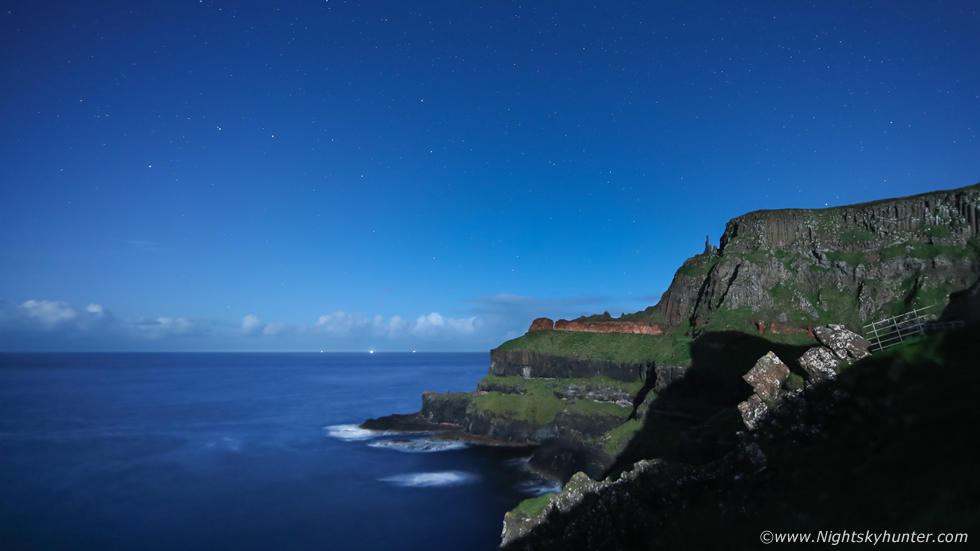 |
It was a fairly lengthy walk, some of it up hill, the trail itself is quite narrow with steep edges, in wet weather it can be dangerous due to mud however tonight the ground was dry and inviting. We made it to the cliff, rounded a corner and were greeted with this wonderful scene. The moon wasn't quite high enough to light up all the cliffs and there was a shadow of the first stack cast upon the second, it could have been better however it was darn nice all the same and I couldn't resist taking a few exposures. I had to climb over the wooden fence then slowly work my way down a slippery slope of grass and rock with cliffs falling into the sea on either side, but from this precarious spot I had a good view of the Causeway cliffs, this is a single exposure in moonlight with distant Cumulus clouds and 'Plough' asterism perched in the northern sky with lunar opposition glow above the horizon.
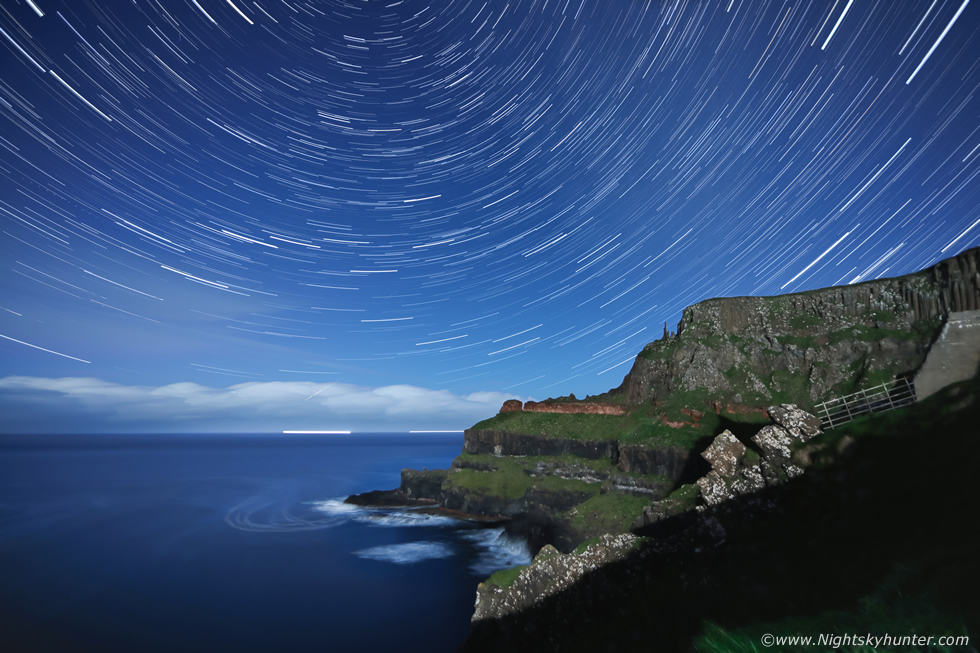 |
I managed to shoot a short star trail with the 5D and had the lens well stopped down to F/4.0, this was my first ever shoot of these cliffs at ground level from this famous tourist trail. I reckon in the rite moonlight this place has great potential and worthy of another go.
 |
This was a special moment, late at night with the moonlit ocean rumbling below us and planet Mars (upper right) like an orange beacon among the stars of Pisces with Perseus and Messier 45 rising from behind these ancient rocks. Check out the bronze colour on these cliffs, Nigel and I thought the orange rocks mimicked orange Mars which made for a striking sight.
 |
Early Autumn, a week of mild high pressure weather which trended on the cloudy side with little in the way of light. On this day I wanted to take advantage of the light wind for drone filming so I made my way into the Sperrins. I flew over the mountain range beside Moneyneany and shot this 180 degree aerial panorama showing the undulating mountains and valleys, the sun broke through a passing Cumulus cloud which then fanned an array of sun beams across one summit turning it into gold. It was a pleasing sight to end the day, the high resolution version of this image looks fantastic.
 |
Autumn saw a favorable apparition of planet Mars when the red planet made a close approach to Earth and coincided with a respectable opposition when it was visible all night as a bright orange-red naked eye star. During the close approach period I undertook a several week observing program where I observed the planet every clear night around midnight with the 8" telescope. I observed the polar cap, polar hood, Syrtis Major and other prominent Martian features. New features would come into view over the weeks and it was my goal to see Oylmpus Mons - the largest volcano of the solar system - as this was something which had always alluded me, I never did get to see it however I was far from disappointed as seeing details on the large disk of any kind is always a special treat.
I wanted to shoot a time lapse of Mars for the record so one clear Autumn night I teamed up with John Fagan at Davagh Forest, we set up our cameras in the astro park near OM Dark Sky Park and Observatory and watched Mars rise over the forest tree tops. We shot two time lapses with the 50mm lenses, this is one of the exposures from the lapse which turned out very well.
 |
While the 600D was time lapsing the red planet I walked over to the entrance at OM, there's a small river passing near the entrance with a stone bridge, I liked the view looking across the curving river, the observatory security lights and red outdoor observing lights combined to illuminate the trees and forest. In the exposure the trees looked red and green which looked very Autumnal contrasting nicely with the stars, I rather liked the look so I spent some time here taking exposures with the 15mm Irix on the full frame Canon 5D Mark IV.
 |
That's the 'Summer Triangle' above the tree tops with Cygnus, Lyra, Aquila and Delphinus. The Milky Way looked particular vivid tonight and I was impressed how well it showed on these 13 second exposures with the lens stopped down, I didn't want to shoot longer as the trees would blow out.
 |
The side of the observatory can be seen here, planets Jupiter and Saturn can be seen getting closer together, they would later being experiencing a very close conjunction in a couple of months. This was a successful mid week night shoot, for once it stayed clear with no clouds and we got exactly what we had come for, a time apse of Mars and a few stills for icing on the cake.
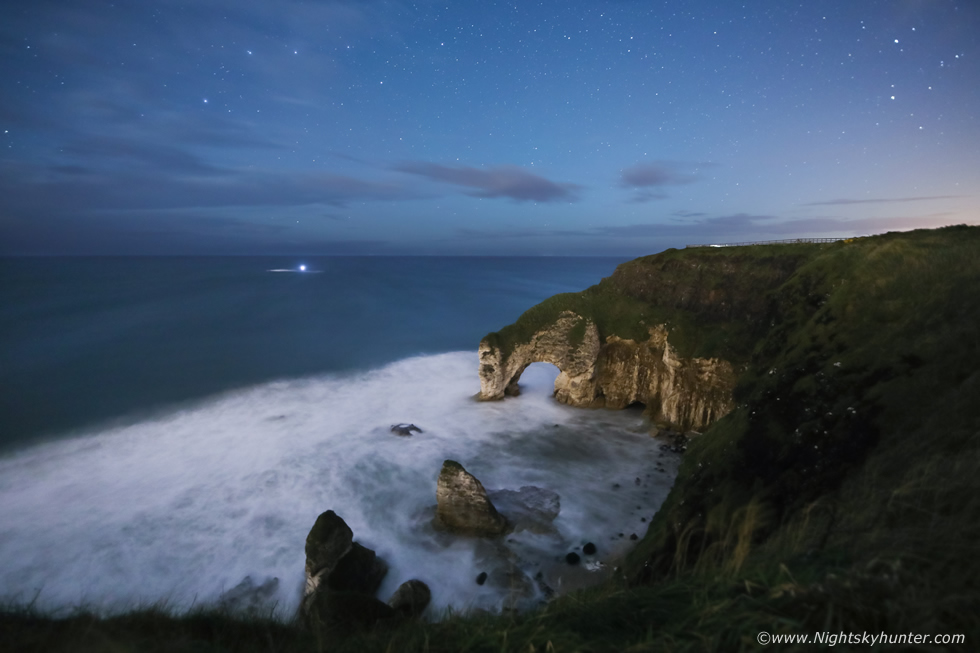 |
A random Autumn night on the Co. Antrim coast, I met up with Nigel McFarland, we had no particular plans other than aligning his new Irix lens with the stars then shooting something. After we got the lens aligned on Mars we drove outside Portrush and pulled into the lay by there and very carefully walked over to the edge. On cliff descened revealing a view with the wishing arc and the northern stars, I had never shot this location at night before so decided to mess about with a few exposures, this was taken with the lowering first quarter moon behind me, the motion of the sea in the long exposure and the stars of Ursa Major and Gemini made for a great scene. I need to return here another time and shoot a time lapse, perhaps with a brighter moon phase higher in the sky.
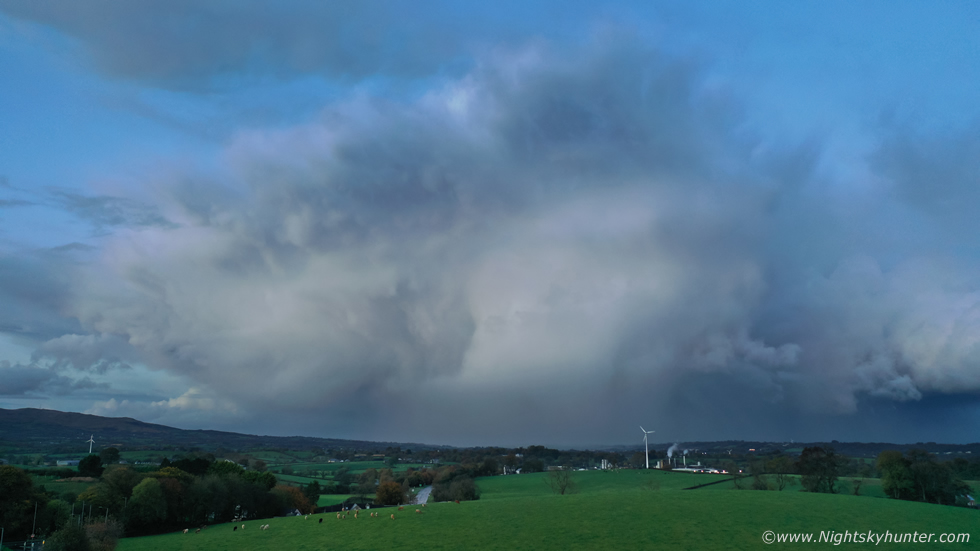 |
Autumn was completely devoid of any proper convection either inland or over the ocean, I never saw a single Cumulonimbus at all, except for this unexpected guy during the last light of day. This was Cookstown, the sun had just set and the sky had that eerie dark blue dusk colour and as light levels dropped fast a cell appeared from the SW and dumped a very intense hail shower over the neighborhood. I waited for it to clear just in case there was something of interest on the back end and sure enough there was, I could see a well formed anvil, the back side of the hail core and solid lumps of mammatus forming, I ran out onto the road and got a few images with the DSLR however the houses blocked the full skyscape, so I grabbed the drone and set-up in a nearby field. This is one of the images from the Mavic 2 Pro with the cell dominating the N/NE sky sector, it looked mean but due to the low light I had to ISO up to 1600 so the timing was rather against me, even so this is the only inland CB I managed to capture this Autumn, I will take it.
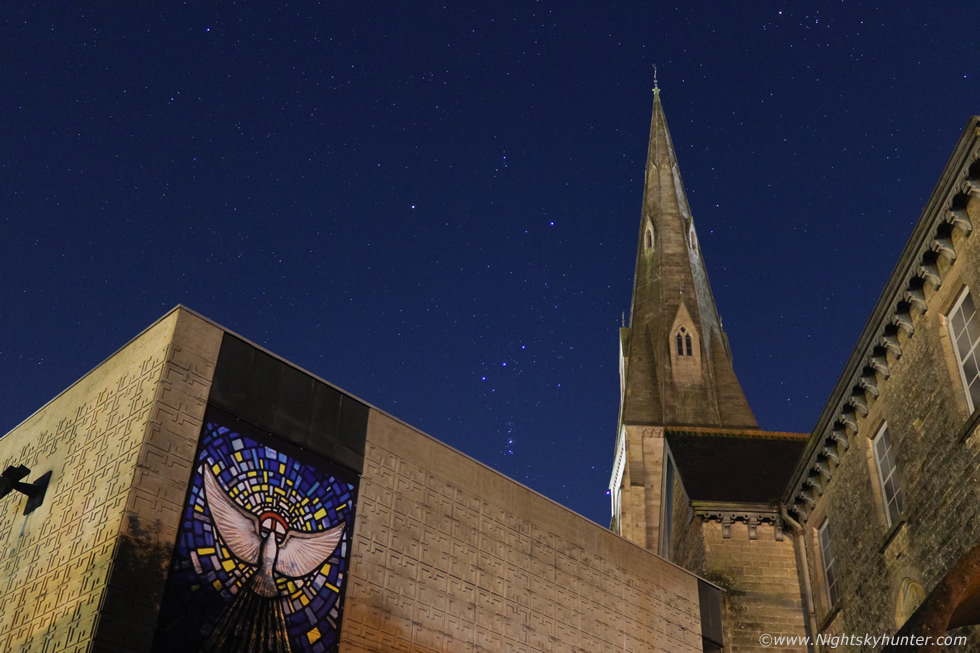 |
Early December in Cookstown, this was 01.00 in the morning, I had went out late deliberately as I wanted to shoot the famous Christmas lights in the town and wanted peace with as few people about as possible which I achieved. Still buzzing from the shoot and not wanting to go home just yet I drove to the top of the down and entered an alley way and got out to admire Holy Trinity chapel. Orion was located perfectly near the spire with M42 clearly visible on the left, it would have been a shame not to take an image of this cool scene. There was a very strange atmosphere at this location, I know it was late at night and the town was silent with nobody around, I could sense the history of this part of town, it felt old and it was almost as if I was transported back to an earlier time. If I had seen a horse and cart I would have legged it.
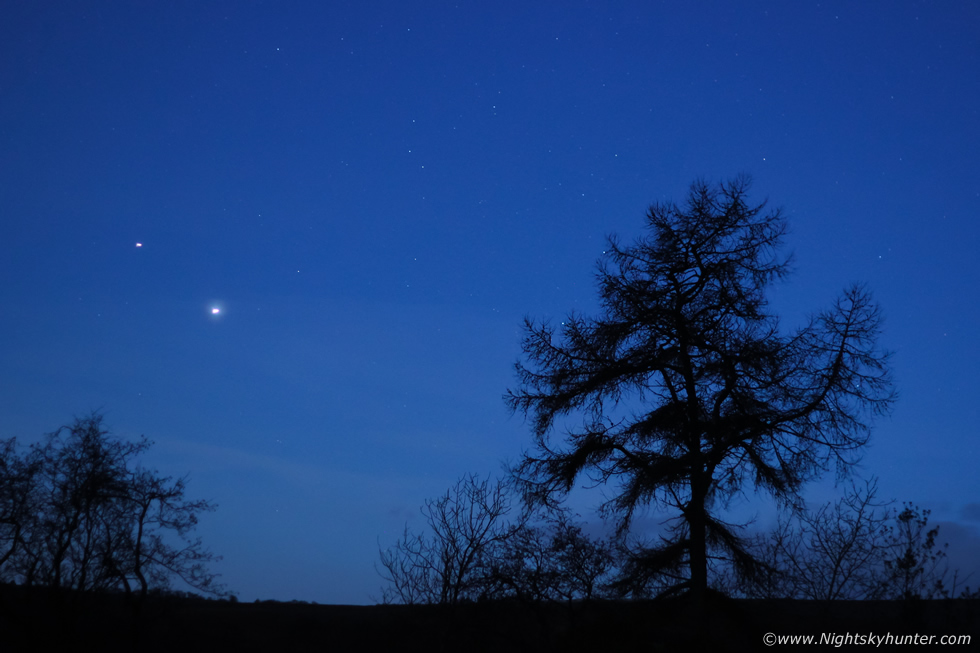 |
During December planets Jupiter and Saturn would be experiencing a very close 'conjunction', each evening the pair would get closer and closer until December 21st when they would be only 6 arc minutes apart, this would be a 'Great Conjunction' and an extremely rare event, in fact, the last such pairing took place in 1623 and even then it wasn't well observed as the planets where badly placed close to the sun, this event would be better and a once in a life time opportunity. The scene would unfold each clear evening low in the S to SW twilight, at closest approach both planets would look like a single star with the naked eye. My intention was to document this event every clear night using stills and time lapse leading up to December 21st.
This was when things began to get dramatic, Jupiter and Saturn where less than 2 degrees or 4 apparent full moon diameters apart. I went to a location I had never been before, on a back road somewhere outside Maghera/Tirkane at the base of Carntogher mountain. I just pulled over at random and got into a mushy field, beside me was a spooky looking old derelict house in the middle of nowhere. After sunset the temperature dropped like a stone and my breath was condensing into a milky cloud and the grass crunched beneath my foot steps. I never saw another living soul and not even a single car which is extremely rare, I was loving the peace and solitude. Here's Jupiter (lower right) and Saturn above the ancient trees which lined the edge of the field in which I stood. This was during twilight/blue hour, I began shooting a time lapse of this scene, the fainter stars belonged to Sagittarius and Capricornus. It was a very successful first night, behind me the full moon rose sporting a pillar, Upper Tangent Arc and twin moondogs.
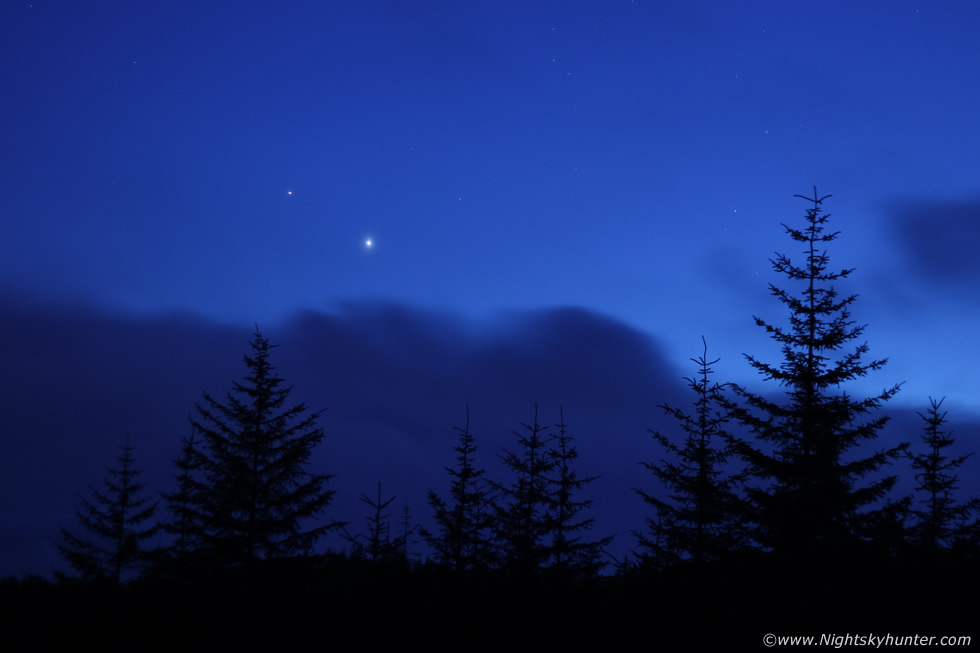 |
A few nights later and the sky cleared again. Due to the planets very low position in the sky it was difficult to get any foreground interest for photography, especially to the SW so I decided to use trees instead to get more of a festive look. This time I was on the top of Glen Shane Pass, I used this cluster of trees beside one of the lay bys for foreground. For this scene I was time lapsing with the 50mm lens and I also had a second camera set up with the 100-400mm, I was shooting a vlog and listening to Christmas music on the radio while periodically checking the cameras, I alternated this with visual sessions with the 24x70mm binoculars. This night both planets where 1.5 degrees apart.
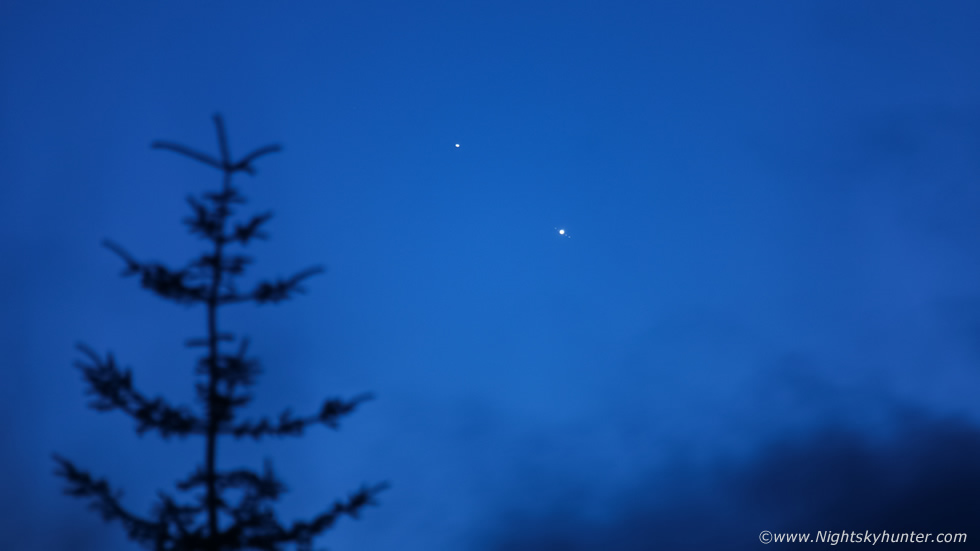 |
An image from the 100-400mm zoomed in much closer, if you look at Saturn you can see that it's elongated, that's because I'm picking up the ring system surrounding the planet however I couldn't resolve the rings at this magnification. You can also see three stars around Jupiter, those are the Jovian moons.
 |
Another Winter evening shoot dedicated to the planets, this time I was with John Fagan and Paul Martin, we met at Beaghmore Stone circles. It was such a beautiful dusk sky, perfectly clear with a lingering sunset afterglow blending into the twilight. I got another good time lapse here with the 50mm F/1.8 lens, the planets were like two silver jewels.
 |
Over an hour later both planets were visible against a dark sky background, this exposure was taken from inside the circles just before they set behind the trees, both time lapses worked out well. I documented the planets on quite a few nights however I won't add all the images on here, the 21st was clouded out so I never got to see them as a single star, however two nights earlier I had a special memory. The sky had suddenly cleared over Cookstown and the conjunction was a spectacular sight, due to their low elevation and atmospheric effects both planets looked like gold unwinking stars against a deep blue twilight, it really was gorgeous.
I called Roisin and Dad out and together we admired the apparition which was a special moment. I took out the 8" telescope and set it up outside the drive way, when I looked in the eyepiece I was blown away. Within the FOV of the 26mm and 20mm eyepieces where both gas giants, I could see golden Saturn with ring system with A ring and B ring and shadow of the planet projected onto the rings, nearby was Saturn's brightest moon Titan. Approximately 10 arc minutes away was Jupiter with three moons and a background star and on the disk were the N and S equatorial belts. Seeing both worlds in the same telescopic field was one of those unique moments of the year which shared the rare category along side comet NEOWISE, the visual spectacle was beyond anything I could have captured on camera.
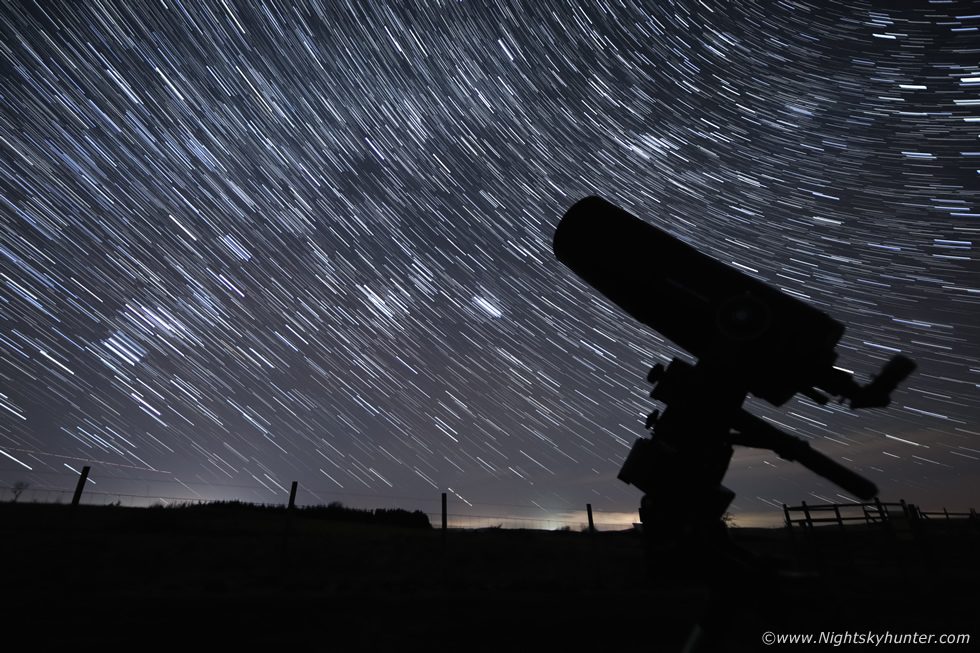 |
Meteor watching, I have to say I have scored lucky this season with the major showers. From Beaghmore Stone Circles with Paul Martin we observed and documented the Geminids and the much rarer Ursids under pristine dark skies. We seen 60 Geminids two nights before maximum and one fireball at mag -8.0. The Ursids on the 21st were a different entity, they are one of the least observed showers of the year due to a low ZHR and being cold at Winter and on the run up to Christmas so only the die hard observers tend to watch it. I used to watch it every year then took a break from it but this year Paul and I decided to dedicate the night to the hunt. Two or possibly three outbursts were forecast all during the pre-dawn hours so Paul and I met at midnight then did a watch to 05.30 local time. We counted 72 Ursids, 6 Geminids and 5 sporadics, including 3 Ursid fireballs. We confirmed enhanced activity between 03.00 and 04.00 and as it turned out we where among a very few number of people who witnessed the outburst as many others were clouded out or just didn't observe.
As it turned out this was one of our best visual observing nights of the year, it was -2C, we stayed out for six hours constantly watching the sky, the sky itself was absolutely perfect with stars to mag +6 visible to the naked eye. The Winter Milky Way looked fantastic and Orion and Sirius were beautiful beyond words. I set up the telescope so we could so some deep sky observing, we admired Messier objects such as M31, M44, M1, M35, M13 then guided the scope towards M42 the Great Orion Nebula. I was blown away, this was the best view I had of the nebula in a very long time, the nebulosity was complex, highly structured and filled the 26mm FOV. We had to defrost the cars then made our way home for 06.30, even though the planet conjunction had been clouded out the previous evening this meteor watch more than made up for it. Above is a star trail of Orion, Hyades and Pleiades with my telescope made from meteor patrol images.
 |
Paul lent me a hand warmer and velcro fastener, I was then able to secure the warmer onto the lens and as a result my lens remained mist and frost free the entire night. I was able to go through two cameras shooting patrol images until all the batteries went dead. Memory star trail with our vehicles and scope.
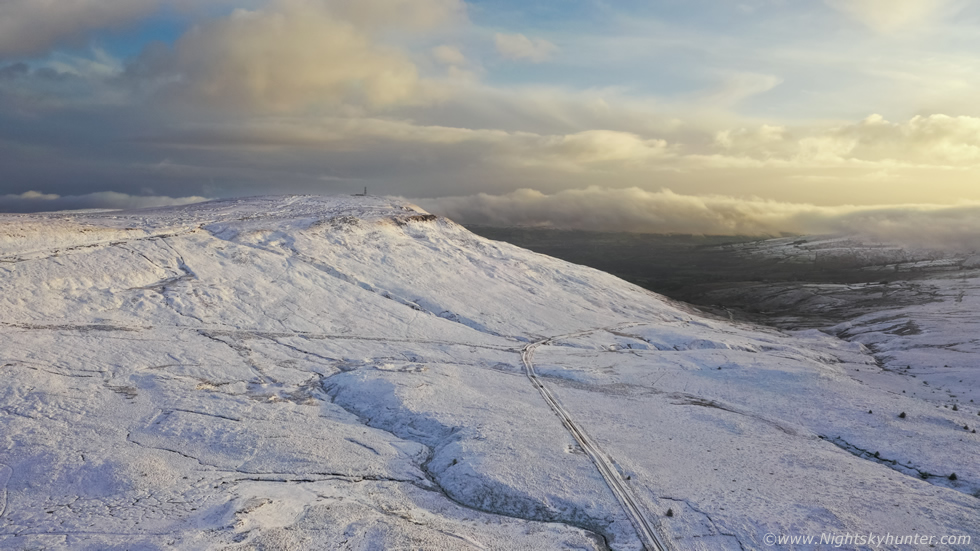 |
December 27th three days before New Year and we had entered the beginning of a week long cold spell. There was little in the way of snow as most of the period was a dry frost and ice event, however a few showers passing over the high ground put down a good dusting on the Sperrins and Glens of Antrim. I ended up on the famous Birren road between Glenshane and Moneyneany and as luck would have it the snow was beautiful here, it looked to be the best location in the local area, we drove from black roads, to a dusting of snow, rounded a bend over a hill then we suddenly emerged into a Winter wonderland. I got the drone up for images and video, this would be my last snow adventure of the year, also another hard lock down was coming on the days ahead so I wanted to make the most of it. Aerial view of Mullaghmore, if you look carefully you can see my van parked just as the road bends.
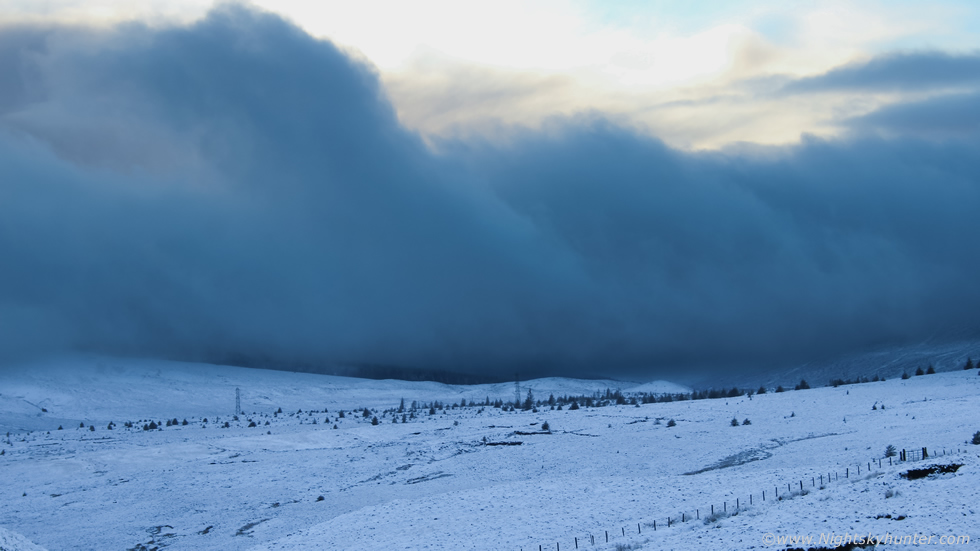 |
Last scene of the day just as the sun was setting behind the Sperrins and backlighting the clouds. This was actually a very cool scene with the naked eye, a long line of low cloud began to pass over the hills, it was almost touching the ground and moving at a swift speed, it looked dramatic over the untouched snow during the last light of day. This brings to an end my 2020 adventures and miscellaneous images, I hope you enjoyed re-living them with me. As I write this at the beginning of 2021 its a new year and I have a brand new telescope and high aspirations for thunderstorms, snow storms and great comets, I hope you can join me to see what nature has to offer, thanks very much for reading.
Martin McKenna